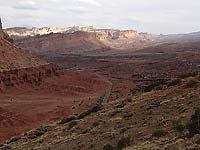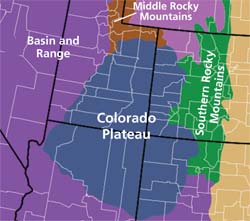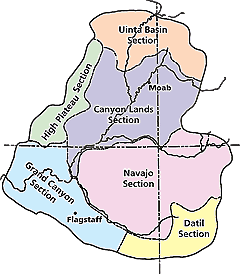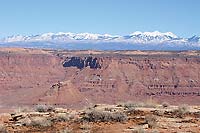The area around Moab is often referred to as “canyon country” for the deep canyons with soaring cliffs that expose thick sequences of sedimentary rocks that characterize the scenery here. Canyon country also includes broad benches with wide-open views of distant cliffs or mountains. Together, canyon country is a landscape that is treasured by hikers, mountain bikers, climbers and jeepers, and especially by geologists.
 |
| Capitol Reef is one of the national parks on the Colorado Plateau |
Geologically speaking, Moab sits in the Colorado Plateau, one of 25 physiographic provinces in the lower 48. Other physiographic provinces in the United States include the Rocky Mountains, the Blue Ridge, the Superior Upland, the Gulf Coast and the Snake River Plain. Physiographic provinces are areas of the continent with unique character, relief and environment that are significantly different than that found in adjacent regions. The Colorado Plateau consists of mostly high desert environments at high elevations, and is a region where the rocks are mostly undeformed. By contrast, earth’s surface has been extensively faulted and folded in the Rocky Mountains to the north and east and in the Basin and Range to the south and west. But the rock layers on the Colorado Plateau mostly have been titled only slightly, if at all, from their original horizontal position.
The Colorado Plateau covers approximately 130,000 square miles and is nearly centered on the Four Corners. It is named for the Colorado River, which along with its tributaries, drains most of the plateau. A plateau is relatively flat elevated region that may be cut by canyons.
 The Colorado Plateau is also notable because it has the greatest concentrations of national parks in the country: nine national parks, including Arches, Canyonlands, Capitol Reef, Bryce Canyon and Zion in Utah, and at least eighteen other national park units including Glen Canyon National Recreation Area and Colorado National Monument. The Colorado Plateau is also home to some of the greatest concentrations of fossils in the world, including petrified wood and early dinosaurs in
Petrified Forest National Park and the abundance of fossil dinosaur trackways around Moab. It is also home to the greatest concentrations of natural bridges and arches in the world, some of the country’s best whitewater in Cataract and Grand canyons, and was the focus of some of the most significant pioneering studies of North American geology, including works by John Wesley Powell and Clarence Dutton, as well as G.K. Gilbert who did ground-breaking research in the Henry Mountains.
The Colorado Plateau is also notable because it has the greatest concentrations of national parks in the country: nine national parks, including Arches, Canyonlands, Capitol Reef, Bryce Canyon and Zion in Utah, and at least eighteen other national park units including Glen Canyon National Recreation Area and Colorado National Monument. The Colorado Plateau is also home to some of the greatest concentrations of fossils in the world, including petrified wood and early dinosaurs in
Petrified Forest National Park and the abundance of fossil dinosaur trackways around Moab. It is also home to the greatest concentrations of natural bridges and arches in the world, some of the country’s best whitewater in Cataract and Grand canyons, and was the focus of some of the most significant pioneering studies of North American geology, including works by John Wesley Powell and Clarence Dutton, as well as G.K. Gilbert who did ground-breaking research in the Henry Mountains.
Beyond its scenery, the Colorado Plateau also has some of the greatest exposures of bedrock anywhere on the planet. Mile upon mile of cliffs are exposed along canyon rims, in upwarps such as the San Rafael Swell and in Monument Valley.
 |
| The Colorado Plateau is divided into 6 distinct sections.
Parts of three physiographic provinces are in Utah: The Basin and Range, the Middle Rocky Mountains and the Colorado Plateau |
Why are the rocks so well exposed here? One reason is that the dry climate limits vegetation. Secondly, there is a relatively rapid rate of erosion along with a slower overall rate of weathering.
Erosion is the process by which rock material is loosened and then transported away via run off during storms, by streams and by the wind. Weathering includes the processes that occur when rock materials are broken down in place (in situ) by chemical and physical processes, but are not transported.
In many climates, weathered rock accumulates and produces soil that buries bedrock. Soils don’t build up here (except in certain low spots or over easily weathered rocks) because broken up rock material is transported readily. The heavy sediment loads and red color of Colorado River after heavy rains attests to this rapid erosion, as does the old description for the Colorado River: “too thin to drink and too thick to plow.”
In many areas on the Colorado Plateau, and particularly in areas with steep slopes, erosion can transport rock fragments away more rapidly than bedrock can be weathered in place, leaving bare rock on the surface. This bare rock forms the cliff faces, domes and slickrock surfaces that dominate the country around Moab.
Moab sits in the heart of the Canyon Lands section of the Colorado Plateau. The Colorado Plateau is divided into six sections, each subtly different from others. The Canyon Lands section is dominated by gently tilted sedimentary rock layers intricately carved into canyons. To the south is the Navajo section, which is largely a platform of sedimentary rock with many isolated mesas and buttes. The Grand Canyon section experienced the greatest uplift of any section of the Colorado Plateau, and thus contains its deepest canyon. The High Plateaus, which include Boulder Mountain and Bryce Canyon National Park, is transitional between the Colorado Plateau and the Basin and Range, and contains a plethora of both volcanic and sedimentary rocks.
 |
| Lockhart Basin exhibits the classic scenery of the Canyon Lands Section |
The Datil section makes up the southeastern portion of the Colorado Plateau and contains large volumes of young volcanic rocks. The Uinta Basin to the north is dominated by thick layers of shale, siltstone and sandstones exposed in vast cliff lines, including the Book and Roan Cliffs.
The Canyon Lands section just might be the most scenic part of the country’s most scenic physiographic province. The Green and Colorado rivers join here, exposing great thicknesses of red, orange and white sandstones, with the La Sal, Abajo and Henry mountains standing above it all.
Geology Happenings will continue to explore the Colorado Plateau, its rocks and its geologic history month after month.
You can read more geology articles from Allyson HERE
A self-described “rock nerd,” Allyson Mathis is a geologist, informal geoscience educator and science writer living in Moab.
A flat-lander by birth from where everything was covered with vegetation, Allyson is much happier exploring deep time in Moab and beyond. |
 |

 The Colorado Plateau is also notable because it has the greatest concentrations of national parks in the country: nine national parks, including Arches, Canyonlands, Capitol Reef, Bryce Canyon and Zion in Utah, and at least eighteen other national park units including Glen Canyon National Recreation Area and Colorado National Monument. The Colorado Plateau is also home to some of the greatest concentrations of fossils in the world, including petrified wood and early dinosaurs in
Petrified Forest National Park and the abundance of fossil dinosaur trackways around Moab. It is also home to the greatest concentrations of natural bridges and arches in the world, some of the country’s best whitewater in Cataract and Grand canyons, and was the focus of some of the most significant pioneering studies of North American geology, including works by John Wesley Powell and Clarence Dutton, as well as G.K. Gilbert who did ground-breaking research in the Henry Mountains.
The Colorado Plateau is also notable because it has the greatest concentrations of national parks in the country: nine national parks, including Arches, Canyonlands, Capitol Reef, Bryce Canyon and Zion in Utah, and at least eighteen other national park units including Glen Canyon National Recreation Area and Colorado National Monument. The Colorado Plateau is also home to some of the greatest concentrations of fossils in the world, including petrified wood and early dinosaurs in
Petrified Forest National Park and the abundance of fossil dinosaur trackways around Moab. It is also home to the greatest concentrations of natural bridges and arches in the world, some of the country’s best whitewater in Cataract and Grand canyons, and was the focus of some of the most significant pioneering studies of North American geology, including works by John Wesley Powell and Clarence Dutton, as well as G.K. Gilbert who did ground-breaking research in the Henry Mountains.

